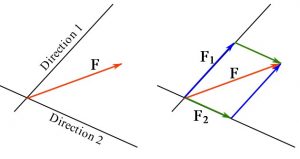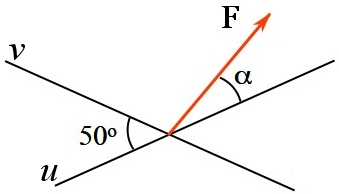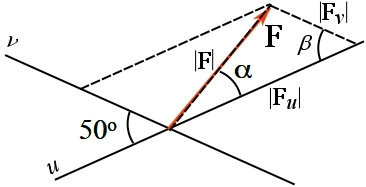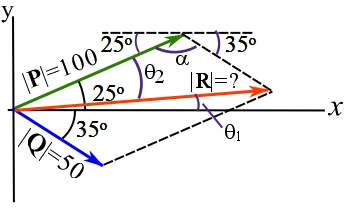Vectors and their Operations: Vector components
If ![]() , it implies that
, it implies that ![]() has two components along the directions or lines of action of
has two components along the directions or lines of action of ![]() and
and ![]() (Fig. 2.13). We can consider decomposing the vector
(Fig. 2.13). We can consider decomposing the vector ![]() into two vector components
into two vector components ![]() and
and ![]() . Given a set of two directions, a unique component of a vector along each direction can be found by decomposing the vectors. Vector decomposition of
. Given a set of two directions, a unique component of a vector along each direction can be found by decomposing the vectors. Vector decomposition of ![]() can be regarded as the reverse of the vector addition, which means finding vectors with known directions (but unknown magnitude) such that their addition equals
can be regarded as the reverse of the vector addition, which means finding vectors with known directions (but unknown magnitude) such that their addition equals ![]() . Decomposing a vector can be performed using the parallelogram rule and trigonometry laws.
. Decomposing a vector can be performed using the parallelogram rule and trigonometry laws.

Vector decomposition produces components of vectors that are parallel with particular axes. The following interactive example shows the process of vector decomposition.
EXAMPLE 2.3.1
The vector ![]() of magnitude
of magnitude ![]() is to be resolved into two components along the lines
is to be resolved into two components along the lines ![]() and
and ![]() . Determine the angle
. Determine the angle ![]() if the component of
if the component of ![]() along the line
along the line ![]() has a magnitude of
has a magnitude of ![]() , i.e.
, i.e. ![]() .
.

SOLUTION
Use the parallelogram rule on the given directions of the component vectors.

![]() because of the parallel sides.
because of the parallel sides.
From Sine Law,
![Rendered by QuickLaTeX.com \[\begin{split}\frac{\sin{\alpha}}{|\bold F_{v}|}&= \frac{\sin{\beta}}{|\bold F|}\\\frac{\sin{\alpha}}{70} &= \frac{\sin{50^{\circ}}}{100}\\\alpha &= 32.4^{\circ}\\\end{split}\]](https://engcourses-uofa.ca/wp-content/ql-cache/quicklatex.com-fa201a0f66630e7d904d0df48cf3889d_l3.png)
EXAMPLE 2.3.2
Determine the resultant vector, ![]() .
.

SOLUTION
Two methods:
Method 1

From geometry: ![]() .
.
From Cosine Law: ![]() .
.
From Sine Law: ![]() .
.
Answer: ![]() ,
, ![]()
parallelogram method, the use of Sine and Cosine laws is cumbersome. To add vectors efficiently systematically, vectors can be decomposed (resolved) onto a set of common directions and the resulting parallel vector components can be simply added.
Method 2
By decomposing the vectors ![]() and
and ![]() on the two perpendicular lines (axes) denoted as x and y.
on the two perpendicular lines (axes) denoted as x and y.

Components of ![]() are as,
are as,
![Rendered by QuickLaTeX.com \[\begin{split}\bold P&=\bold P_x+\bold P_y\\|\bold P_x|&=|\bold P|\cos 25^ \circ=90.6\\|\bold P_y|&=|\bold P|\sin 25^\circ=42.3\end{split}\]](https://engcourses-uofa.ca/wp-content/ql-cache/quicklatex.com-1c1f8c3d90a512caec307017f8e10854_l3.png)
Components of ![]() are as,
are as,
![Rendered by QuickLaTeX.com \[\begin{split}\bold Q&=\bold Q_x+\bold Q_y\\|\bold Q_x|&=|\bold Q|\cos 35^ \circ =41.0\\|\bold Q_y|&=|\bold Q|\sin 35^\circ=28.7\end{split}\]](https://engcourses-uofa.ca/wp-content/ql-cache/quicklatex.com-da88ae89f0e348597d1af22f7ff9d295_l3.png)
Solving for ![]() :
:
![Rendered by QuickLaTeX.com \[\begin{split}\bold R&=\bold P+\bold Q\\&=(\bold P_x+\bold P_y)+(\bold Q_x+\bold Q_y)=(\bold P_x+\bold Q_x)+(\bold P_y+\bold Q_y)\\&=\bold R_x + \bold R_y \\&|\bold R_x|=|\bold P_x|+|\bold Q_x| = 131.6 \\&|\bold R_y|=|\bold P_y| - |\bold Q_y| = 13.6\end{split}\]](https://engcourses-uofa.ca/wp-content/ql-cache/quicklatex.com-be76db32eebb4cab7b327c487132d1e6_l3.png)
Therefore:
![Rendered by QuickLaTeX.com \[\begin{split}|\bold R|&=\sqrt{|\bold R_x|^2+|\bold R_y|^2}=132\\\tan \theta_1 &=\frac{|\bold R_y|}{|\bold R_x|}=\frac{13.6}{131.6}\\ &\implies \theta_1=5.9^{\circ}\end{split}\]](https://engcourses-uofa.ca/wp-content/ql-cache/quicklatex.com-5a2fe53d360fcc947a526cff64a35d7f_l3.png)
Answer: ![]() ,
, ![]()
In the above example, the vectors are resolved into their components on the given axes and the parallel components of the vectors are added. Then, adding the resultant vectors on the axes gives the final resultant vector. This approach is a systematic approach for adding vectors.
